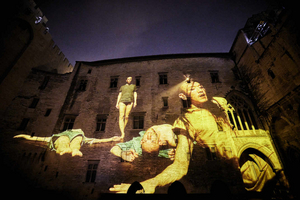Review: The Festival d'Avignon Presents FUTUR PROCHE By Jan Martens
Jan Martens has understood the need for scale with this production.

Seated in the middle of a meters long bench in Avignon's Cour d'Honneur, Goska Isphording whirls through compositions on the harpsichord in front of her. Through deep concentration she executes rhythmic repetition with tongue twister like variations. It is understandable that Jan Martens has given her pride of place in his Futur Proche, which was premiered by Opera Ballet Vlaanderen last night in the Festival d'Avignon. Her presence elevated the dance composition, turning the dancers from plastic movement, to figments of her musical imagination.
Under the costume design of Joris van Oosterwijk and Jan Martens, performers wear fairly contemporary clothing. Some are dressed to move, some are dressed for brunch. Oosterwijk also designed the long park bench that bisects the Cour d'Honneur stage. These two design elements make the first part of the work call to mind the joyful urbanism of the NYCB, particularly Jerome Robins, or Justin Peck. When my eye settled on stillness in this portion, whether it be Isphording on the harpsichord, or two young dancers sitting on the bench and seeming to take in the spectacle, the work's impact strengthened. Too much concentration on any individual person romping around the bench narrows Marten's choreographic effect. Instead the event can be taken in with the absentmindedness of people-watching on a crowded street.
The second portion included Stijn Pauwels's impressive video work. A small camera is put on stage and dancers enter into Elke Verachtert's amber lighting. Their entrances dominate on the back wall of the Cour d'Honneur through a live projection. The dancers look straight into the on stage camera. None, it seems, look up to the thirty meter tall projection itself. It is a display of self-control that I can't quite imagine for myself. Every aspect of their movement, their body, and their affect is magnified for all to see.
The third portion, despite a slight set change with taking apart the park bench and placing it in places around the theatre, is generally more of the same from part one. Only here, it is more disjointed. There is no general rush of the dancers, as fragmented individuals demand to be engaged with on their own terms. A spotlight grazes across this young cast of performers. In the final silent image a large tub is brought out and is filled with water from backstage. Four dancers at a time enter and wash themselves.
Jan Martens has understood the need for scale with this production. Goska Isphording took on the task of a full orchestra with her thrilling harpsichord performance. The intimacy of the final images was hard to register in such a cavernous and voyeuristic space as La Cour d'Honneur. Though the daring of his projection work, and swirling early compositions made excellent use of the space. He wants his Futur Proche to register socially and never overstates his case. The watchful eyes of young dancers sitting on a bench as the world swirls around them is enough.
Photo Credit: CHRISTOPHE RAYNAUD DE LAGE
Reader Reviews

Videos
